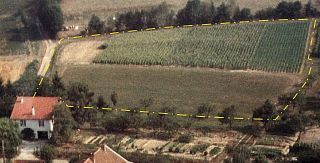
Under my trees…
The Clouzeaux Park
In 1992, when the family farm ceased operation, I decided to recover the ground adjoining our house to the north and to establish a “little park”. On the land registry, that plot was named “The Clouzeaux”, whence the name of my park.
The above aerial photo depicts this piece of land when it was being farmed back in 1985. This view of our property, which encompasses our house and garden, measures two acres. The plot destined to be forested (circled in yellow) measures one and one half acre.
I began the plantation in the winter of 1991/1992. First, I bought one hundred “red American oaks”, and a few Douglas pines and ordinary walnut trees. Those seedlings were of poor quality, so during the first year, there were many losses. At the same times, I undertook the planting of other trees such as ashes, cherry trees, hybrid walnut trees, oaks and chestnut trees. This new hobby was most enjoyable and pleased me very much. I would never have imagined how easy it would be to produce those trees in my garden starting from seeds and kernels, especially producing trees of better quality. Consequently, during the second and third year, I expanded the plantation, producing about 1,500 young trees. On the above photo taken in the autumn of 1993, we can see in the foreground an American red oak. Those first years of plantation required much physical work and efforts on my part, along with a few disappointments because of the loses among the purchased seedlings ( 1/3 of the oaks and the entire crop of Douglas pines were lost)
During my travels to the bamboo plantation at Anduze (Gard region), I brought back a few specimens of bamboo which adapted very well to our climate. Even ice and snow do not seem to impair those trees. Under the weight of the snow, bamboo bend, but they do not break… (Photo January 1999)
Now, the assortment of trees is quite varied: Common and American oaks, ashes, cherry trees, walnut trees, chestnut trees, hornbeams, beeches, birches, maples, hazelnut trees, bamboo and many fruit bearing trees. Only poplars and resinous trees are absent.
From the beginning, I needed to learn about tree growing techniques, the objective being the production of rectilinear stumps from 25 to 30 feet as well as learning about cutting and pruning (Photo December 1999). Dreading not being able to continue this work for too many more years, I increased the annual pruning before the branches became too large. This work is done especially in autumn and winter. During the warm season, it is necessary to mow and keep the ground under the trees clear. This must be done at least twice a year.
Along with the passing of my years, I feel a great satisfaction watching my trees growing. Each season has its appeals: the spring with the nature’s awakening, buds and foliage tender green; the summer with the unbelievable vigor of young boughs, the shade increasingly compact; the autumn with the various colors of foliage; the winter with the denuded trees and the carpet of dead-leaves on the ground. The photo above shows the astonishing development of this plantation, hardly ten years after the planting of the first seedling.
Last improvement to “my little park”: an access gate (October 2001)